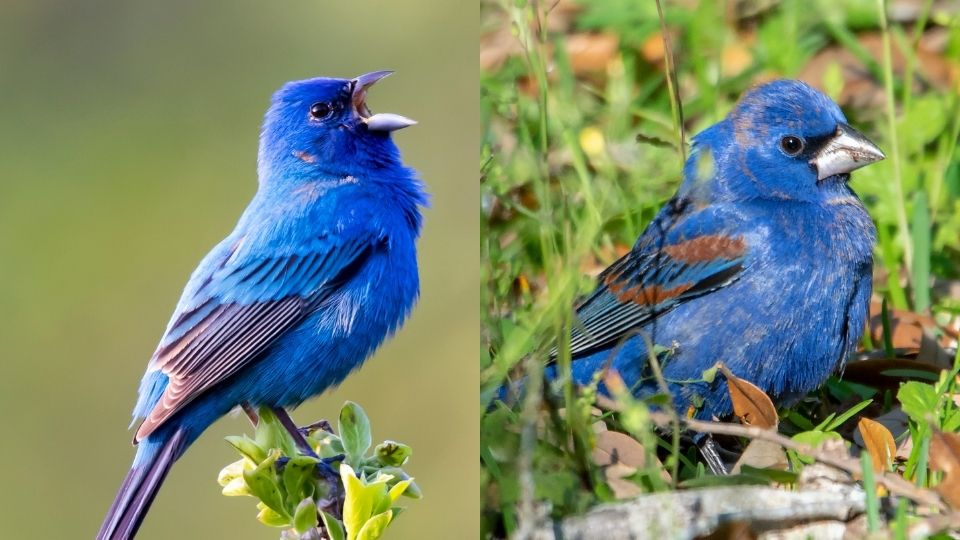To tell the difference between an indigo bunting vs blue grosbeak, look at the style of the bill. Blue grosbeak songbirds have large rounded silver beaks, while the indigo bunting has a smaller darker beaks. Blue grosbeaks have darker blue plumage, are larger in size, travel further south, and don't typically eat at bird-feeders.
Can’t you tell the difference between an Indigo Bunting and a Blue Grosbeak? You’re not alone! While they look very similar, minor differences make it simple to tell these two doppelgangers apart.
Blue grosbeaks and Indigo buntings are both members of the cardinalidae family and share more in common than just their blue plumage. At a glance, it’s almost impossible to tell the difference between these two songbirds. However, upon closer inspection, slight differences in the color of their feathers, shape, habitats, and behavior make it easy to spot the difference quickly.
Physical Characteristics
While they look like the same bird in a photo, you can likely spot a few key differences in color and physical traits. Let’s take a deeper dive into the physical characteristics of these two songbirds.
Color
Both birds are, indeed, blue. But if you look closely, the male indigo bunting has a light blue coloring, while the male blue grosbeak has deep blue feathers on its upper parts. Additionally, the male blue grosbeak has rusty wing bars, making its blue feathers pop. If you spot these two birds side-by-side, the blue grosbeak has brighter and more conspicuous plumage when compared to the indigo bunting.

Bill Shape
Another great way to spot the difference is by examining the size of the bills. Blue grosbeaks have a sizable conical-shaped bill that takes up almost the total size of their head, similar to the Northern cardinal! Compared to their head shape and eyes, the bill of the blue grosbeak seems large and exaggerated. The indigo bunting has a similar-shaped conical bill but isn’t quite as large as the blue grosbeak.
Size
The overall size of these two wild birds is another great way to tell them apart. While they may seem similar, the blue grosbeak is slightly larger and plumper than the indigo bunting. Blue grosbeaks have a length of up to 19 inches long, a wingspan of up to 29 inches, and a weight of around one ounce. The indigo bunting measures up to 13 inches long, has a wingspan of only 9 inches, and weighs .63 ounces.
Natural Habitats
To make matters even more confusing, the habitats of the indigo bunting and blue grosbeak often overlap. Both songbirds spend the breeding season in most parts of the United States and migrate to Mexico or Central America for their wintering grounds. The blue grosbeak prefers warmer climates in the southern portion of the United States in places such as Texas and Arizona.
At the same time, the indigo bunting is found primarily in the eastern part of North America in areas such as Florida, New York, and the Midwest. While both are migratory birds, the indigo bunting travels further into Central America. Indigo buntings don’t often nest in thick deciduous forests. Instead, they make nests in brushy areas, forest edges, old fields, or thickets that are typically only three feet off the ground.
Like the indigo bunting, blue grosbeaks also make nests in open areas and along roadsides. Their nests are low to the ground and range anywhere from three to ten feet off the ground. While their natural habitats are very similar, migrant blue grosbeaks flock to warmer areas, while indigo buntings are often found farther north.
Diet
The diet of the indigo bunting and the blue grosbeak are very similar. Both birds stick to a diet of insects during breeding and switch to small seeds and berries during non-breeding months. While their diets are very similar, the indigo bunting is more likely to show up at your backyard feeders than a blue grosbeak.
Indigo buntings are far more familiar with people and other songbirds and won’t shy away from backyard feeder offerings. However, the more elusive blue grosbeak doesn’t often frequent backyard bird-feeders, although you can try to attract them with sunflowers seeds or mealworm suet.

Other Songbirds Similar to the Indigo Bunting and Blue Grosbeak
The indigo bunting and the blue grosbeak aren’t the only two confusing blue birds in town. These two similar songbirds often get mistaken for similar birds, such as the bluebird, lazuli bunting, painted bunting, or passerina buntings. Telling the difference between various bluebirds often boils down to where you are. The painted bunting, for instance, prefers warmer climates in the south portion of North America and is rarely spotted further north. Bluebirds, on the other hand, are more common on the east coast and as far west as the Great Plains.
If you spot a bird at your backyard feeders, noting your location and time of year and paying close attention will help you determine which blue bird you have spotted. Also looking at minor details like the brightness of its plumage, bill shape, and overall behavior is a great way to become a blue-bird-spotting expert. If you confuse them, rest assured you aren’t the only one!

